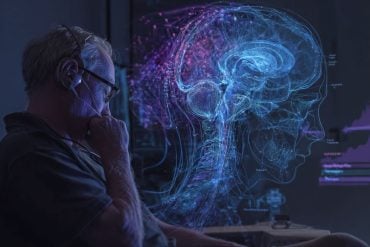Summary: Machine learning algorithms were able to distinguish, with 73% accuracy, neurobiological differences between those with dissociative identity disorder and those without the condition.
Source: King’s College London.
Machine-learning and neuroimaging techniques have been used to accurately distinguish between individuals with Dissociative Identity Disorder (DID) and healthy individuals, on the basis of their brain structure, in new research part funded by the NIHR Maudsley Biomedical Research Centre and published in the British Journal of Psychiatry.
Researchers performed MRI (magnetic resonance imaging) brain scans on 75 female study participants — 32 with independently confirmed diagnoses of DID and 43 who were healthy controls. The two groups were carefully matched for demographics including age, years of education and ancestry.
Using machine-learning techniques to recognise patterns in the brain scans, the researchers were able to discriminate between the two groups with an overall accuracy of 73%, significantly higher than the level of accuracy you would expect by chance.
This research, using the largest ever sample of individuals with DID in a brain imaging study, is the first to demonstrate that individuals with DID can be distinguished from healthy individuals on the basis of their brain structure.
DID, formerly known as ‘multiple personality disorder’, is one of the most disputed and controversial mental health disorders, with serious problems around under diagnosis and misdiagnosis. Many patients with DID share a history of years of misdiagnoses, inefficient pharmacological treatment and several hospitalisations.
It is the most severe of all dissociative disorders, involving multiple identity states and recurrent amnesia. Dissociative disorders may ensue when dissociation is used as a way of surviving complex and sustained trauma during childhood, when the brain and personality are still developing.

Dr Simone Reinders, Senior Research Associate at the Department of Psychological Medicine, Institute of Psychiatry, Psychology & Neuroscience, King’s College London led the multi-centre study involving two centres from the Netherlands, the University Medical Centre in Groningen and the Amsterdam Medical Centre, and one from Switzerland, the University Hospital in Zurich.
Commenting on the research, Dr Reinders said: “DID diagnosis is controversial and individuals with DID are often misdiagnosed. From the moment of seeking treatment for symptoms, to the time of an accurate diagnosis of DID, individuals receive an average of four misdiagnoses and spend seven years in mental health services.
“The findings of our present study are important because they provide the first evidence of a biological basis for distinguishing between individuals with DID and healthy individuals. Ultimately, the application of pattern recognition techniques could prevent unnecessary suffering through earlier and more accurate diagnosis, facilitating faster and more targeted therapeutic interventions.”
Funding: The research was funded by the NIHR Maudsley Biomedical Research Centre.
Source: George King – King’s College London
Publisher: Organized by NeuroscienceNews.com.
Image Source: NeuroscienceNews.com image is in the public domain.
Original Research: Abstract for “Aiding the diagnosis of dissociative identity disorder: pattern recognition study of brain biomarkers” by Antje A. T. S. Reinders, Andre F. Marquand, Yolanda R. Schlumpf, Sima Chalavi, Eline M. Vissia, Ellert R. S. Nijenhuis, Paola Dazzan, Lutz Jäncke and Dick J. Veltman in British Journal of Psychiatry. Published December 7 2018.
doi:10.1192/bjp.2018.255
[cbtabs][cbtab title=”MLA”]King’s College London”Computers Can Spot the Difference Between Healthy Brains and Those with Dissociative Identity Disorder.” NeuroscienceNews. NeuroscienceNews, 7 December 2018.
<https://neurosciencenews.com/ai-did-brain-10312/>.[/cbtab][cbtab title=”APA”]King’s College London(2018, December 7). Computers Can Spot the Difference Between Healthy Brains and Those with Dissociative Identity Disorder. NeuroscienceNews. Retrieved December 7, 2018 from https://neurosciencenews.com/ai-did-brain-10312/[/cbtab][cbtab title=”Chicago”]King’s College London”Computers Can Spot the Difference Between Healthy Brains and Those with Dissociative Identity Disorder.” https://neurosciencenews.com/ai-did-brain-10312/ (accessed December 7, 2018).[/cbtab][/cbtabs]
Abstract
Aiding the diagnosis of dissociative identity disorder: pattern recognition study of brain biomarkers
Background
A diagnosis of dissociative identity disorder (DID) is controversial and prone to under- and misdiagnosis. From the moment of seeking treatment for symptoms to the time of an accurate diagnosis of DID individuals received an average of four prior other diagnoses and spent 7 years, with reports of up to 12 years, in mental health services.
Aim
To investigate whether data-driven pattern recognition methodologies applied to structural brain images can provide biomarkers to aid DID diagnosis.
Method
Structural brain images of 75 participants were included: 32 female individuals with DID and 43 matched healthy controls. Individuals with DID were recruited from psychiatry and psychotherapy out-patient clinics. Probabilistic pattern classifiers were trained to discriminate cohorts based on measures of brain morphology.
Results
The pattern classifiers were able to accurately discriminate between individuals with DID and healthy controls with high sensitivity (72%) and specificity (74%) on the basis of brain structure. These findings provide evidence for a biological basis for distinguishing between DID-affected and healthy individuals.
Conclusions
We propose a pattern of neuroimaging biomarkers that could be used to inform the identification of individuals with DID from healthy controls at the individual level. This is important and clinically relevant because the DID diagnosis is controversial and individuals with DID are often misdiagnosed. Ultimately, the application of pattern recognition methodologies could prevent unnecessary suffering of individuals with DID because of an earlier accurate diagnosis, which will facilitate faster and targeted interventions.
Declaration of interest
The authors declare no competing financial interests.






